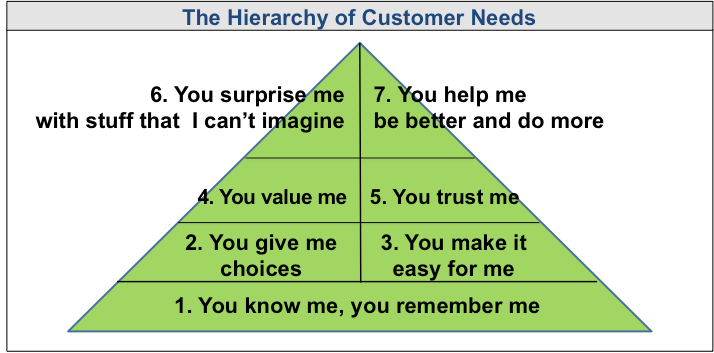Soon after my co-author David Jaffe and I got our 1st book published (The Best Service is No Service: Liberating Your Customers From Customer Service, Keep Them Happy and Control Costs, Wiley/Jossey-Bass, 2008), we got a lot of comments on its final chapter that we called “Deliver great service experiences”. Some of these comments noted that delivering them would be harder if you implemented the core concepts in Best Service (eliminate dumb contacts and produce automation and self-service that work); others noted that service experiences weren’t broad enough – that you have to look at end-to-end customer experiences.
We agreed, and started to research why some companies “get it,” and wanted to find out how they were able to deliver great customer experiences on an end-to-end basis — companies like Amazon, Apple, Danaher, Nike, Nordstrom, Starbucks, and USAA that are based in the US, many truly global players; and companies like Hilti, Vente-Privee, and Yamato Transport that are based outside of the States. We met with these and other customer experience leaders – companies whose multi-year shareholder returns, ACSI scores (or the equivalent), NPS, CES (Customer Effort Scores), and other metrics far eclipsed their peers – and discovered some startlingly simple tenets:
1. They no longer believed that they could “manage” their customers; rather, they embraced that “the customer is in charge”. As Amazon now puts it, “we start with the customer and work backwards”.
2. Their corporate culture was so deeply surrounding customer experience that it was often hard for them to express it.
3. They went the extra mile to ensure that their entire workforce, not just “customer-facing employees,” were empowered and energized to “do the right thing,” as Nordstrom lays out in their training manual (that’s the entire manual!).
They demonstrated from top to bottom, across all teams, and with their partners what we wound up calling Me2B as the replacement for “B2B” or “B2C,” both of which start with the business. Instead, these Me2B Leaders truly live the “inverted pyramid” placing the customer at the top. As a result of our interviews and research we produced “book 2”: Your Customer Rules! Delivering the Me2B Experiences That Today’s Customers Demand (Wiley/Jossey Bass, 2015).
When we talked with these Me2B Leaders we heard story after story after story, augmenting minimal training (see again the Nordstrom one-liner) and constant feedback loops with their relentless focus on the customer needs, both expressed and unexpressed. Taking the one step further we teased out “7 Customer Needs” in a hierarchy reminiscent of the Maslow Hierarchy of Needs. Each “needs” wound up with 5 or 6 sub-needs and, importantly, was viewed as equally applicable to deliver great employee experiences. Makes sense, doesn’t it? Unless your employees have great experiences, how can your customers have a chance to have great experiences?
Here’s how the 7 Customer Needs for Me2B lay out:

Each of these 7 Customer Needs that lead to the winning Me2B culture is explicitly expressed in the customer’s voice. This makes it easy to measure the depth and intensity of Me2B, e.g. with speech or data mining customer calls, email, chat threads, and social posts; it also makes it easy for the customer-facing employees to hear them, and feel better about their companies and thereby reinforce their own positive experiences. Or, if employees do not believe that they apply to
Let’s look at each one.
We start with “You know me, you remember me” across multiple channels (creating the “omni-channel” experience many companies are trying to achieve), across time, among the customers’ families and connections. One of my favorite “bad stories” is when the hotel check in clerk asks “Is this the first that you have stayed with us?” Think about how off-putting that is for the frequent guest!
Based on knowing customers, you then want them to say “You give me choices” and “You make it easy for me”. Choices mean that the customer does have control, rather than being told what’s best for them. Easy ties into the rapidly growing Customer Effort Score (CES) that Me2B Leaders explicitly or implicitly score in the top echelons by focusing like a laser to remove the barriers for their customers and for their employees to work with customers.
We then build one more layer with “You value me” and “You trust me,” both essential to win the hearts and wallets of customers. Value means listening and acting upon the voice of the customer in what we saw as (a) what customers say and don’t say, and (b) what customers do and don’t do. Trust includes not challenging the customer’s version of events and not treating all customers like fraudsters, among other important insights.
And finally we get to “You surprise me with stuff that I can’t imagine” and “You help me better, you help me do more”. One of my favorite “good stories” for surprise is where companies enable customers to say “you treat me like a new customer all the time,” while help stretches through the customer journey and anticipates what’s best for the customer, all the time.
So that’s it – a quick intro to Me2B. In my next several columns we will explore the “Four Foundations” that are needed to produce these 7 Customer Needs, some of the best stories – both bad ones and good ones – and the four types of Me2B Leaders.




This is tryuly a great article. I agree with you
Me2B I understand, though first I though of me (cust service) focused on customer
Welcome, Bill, to the Advisor team. Have been reading your great stuff for a long time! Looking forward to your valuable insights and words of wisdom!
Our research shows that today’s customers also value organizations that assume a mentoring role–constantly looking for ways to leave customers smarter because of their experiences. Great mentoring relationships are learning partnerships with reciprocal learning–the customer teaching the organization as the organization teaches the customer.
Welcome as an Advisor. Good to have you with us.
From all that I know about CX, it feels like the essence of delivering Me2B product and service value, i.e. meeting and exceeding customer needs, is, indeed, culturally-driven. Desired customer behavior is much more about advocacy-building, transcending transactional and tactical metrics like ACSI, NPS, CES, etc. All of the customer needs you’ve identified are vital to value delivery, and their dynamics inside and outside of the organization require more actionable research.
Culture, from my perspective, is too complex for metrics like ACSi, CES and NPS to address (http://customerthink.com/comcasts-nps-gamble-can-the-metric-help-fix-the-customer-experience-culture/) For Me2B cultural direction, my reference points are concepts and executional approaches expressed in books like Conscious Capitalism and Firms of Endearment: http://beyondphilosophy.com/is-being-human-with-customers-a-new-concept-and-does-it-create-emotional-experiential-social-and-financial-value/ and http://customerthink.com/inside_out_advocacy_creating_and_sustaining_customer_centricity_and_loyalty/
Hi Bill – first, welcome! This hierarchy seems sensible, and easy to understand. Which often leads to false confidence: things that are easy to grasp can appear easy to implement. But these seven are exceedingly tough.
I’m wondering where CSR – Corporate Social Responsibility – fits. As a consumer, I must feel positive about my purchase. Example: I can purchase from a clothing retailer that performs splendidly at fulfilling every need on the hierarchy. But post-purchase, if I learn that the company sources its products from factories that employ child labor, or has lax (or non-existent) worker protection, I feel cruddy, and might return what I bought. Either way, I won’t buy from that vendor again until I see substantial evidence that the issues have been rectified.
Fortune 500 companies spend more than $15 billion on CSR programs, according to a 2014 article. It’s hard to know what proportion of that spend is directed toward achieving a revenue goal, but I’m assuming a sizable chunk of the $15 billion aims to fill a compelling customer need: to feel positive about the purchase and the company that produced the product.